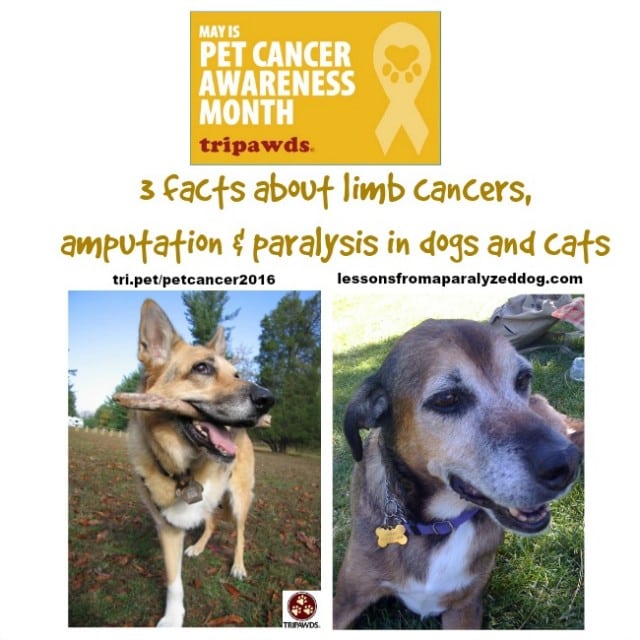May is Pet Cancer Awareness Month and today we’re teaming up with our friend Sharon from Lessons from a Paralyzed Dog to share facts about limb cancer, amputation and pet paralysis.
Like Tripawds, Sharon offers support to worried pet parents. Her website, Lessons from a Paralyzed Dog helps folks cope with the physical and emotional needs of temporarily or permanently paralyzed dogs. Inspired by her beloved dog Sophie, Sharon has the best support for dog paralysis on the Internet. Stop by and check out her blog and all the amazing resources she has for humans and pets. Check our her post for today “Teaming Up With Tripawds for Pet Cancer Awareness Month.”
Three Facts About Limb Cancer, Amputation and Pet Paralysis in Dogs and Cats
Most people who join Tripawds have dog or cat who has been diagnosed with one of three common limb cancers that often leads to amputation:
Osteosarcoma
- Large and giant breed dogs are most likely to be diagnosed with osteosarcoma. But as we’ve seen in our community, osteosarcoma can even happen to toy breeds like Chihuahuas. Osteosarcoma can also appear in the scapula and other bones, such as the skull or spine.
- Recognizing the signs of osteosarcoma can be tricky because animals are so good at hiding their pain. Osteosarcoma often presents as a persistent limp in one leg, but not always. Many diagnoses are delayed because the condition is often mistaken for arthritis.
- Treatment usually begins by amputating the affected limb. Some animals who aren’t good amputation candidates may be good ones for limb salvage surgery, bisphosphonates or stereotactic radiation therapy. Statistically speaking, osteosarcoma chemotherapy gives dogs and cats a better shot at longevity, but there are no guarantees.
More information: Bone and Joint Tumors in Dogs
Soft Tissue Sarcomas
- According to the Sarcoma Alliance, about 15 percent of skin lumps and 7 percent of subcutaneous lumps in dogs are soft-tissue sarcomas. About 1 in every 10,000 cats will develop an injection-site soft-tissue sarcoma.
- Soft tissue sarcoma subtypes include fibrosarcoma, peripheral nerve sheath tumors, malignant fibrous histiocytoma, hemangiopericytoma, and synovial cell sarcoma.
- Soft tissue sarcomas are often difficult to eliminate because a tumor can have long tendrils that invade surrounding tissues. When located on a leg, a soft tissue sarcoma can be impossible to remove because legs just don’t have a lot of tissue to work with. Soft tissue sarcomas can metastasize in the blood and lymphatic routes, but not always. Survival statistics for each type will vary depending on cancer grading results.
More information: Animal Cancer and Imaging Center
Mast Cell Tumors
- About 20% of cutaneous (skin) tumors in dogs and cats are Mast Cell Tumors. According to Dr. Karen Becker, “Dogs usually develop a single tumor. More cats than dogs develop multiple tumors.â€
- Mast cell tumors are tricky. Sometimes they resemble a pencil eraser, other times they feel like a lipoma (fatty deposit). You cannot tell the difference just be feeling it with your fingers, a lump needs a biopsy to know for sure. Never ignore a lump, always See Something, Do Something to ensure your pet doesn’t have a mast cell tumor.
- Mast cell tumors can happen to dog and cats of any age, even kittens! Survival rates vary depending on the grading of the cancer.
More information: Mast Cell Tumor: This is One Lump You Can’t Ignore
and Tripawd Talk Radio: Mast Cell Cancer in Dogs and Cats
Get the Facts About a Dog’s Life on Three Legs
Three Considerations After a Pet Cancer Diagnosis and Amputation Recommendation
Whether your dog or cat has been diagnosed with an osteosarcoma, soft tissue sarcoma or mast cell tumor, amputation may be recommended if removing the tumor with “clean margins” is too difficult. Further treatment to prevent or delay metastasis can vary depending on the animal’s health history, physical condition and owner’s financial considerations. The three most important things to consider when trying to choose a treatment path are:
Dogs and Cats Don’t Keep a Calendar.
Despite their prognosis, animals live in the Here and Now. They don’t think about “What ifs†or tomorrows, they just want to make this moment the very best it can be, whether that means chasing a ball or catching sunbeams. Follow their lead, do not focus on things that are out of your control. All you have is today. Make the most of it with your best friend. Be More Dog (or cat!).
Second Opinions Matter.
If your current vet says your animal isn’t a good candidate for amputation or cancer treatments, get another opinion from a board-certified specialist. Second opinions have proven worthwhile for many members in our community whose dogs or cats were able to enjoy more quality time with their humans. As Dr. Nancy Kay says,
“If your gut is telling you, ‘Maybe I should get a second opinion,’ I strongly encourage you to obtain a consultation with a veterinary specialist. Even if the news about your pet isn’t good, guaranteed you will walk away with greater peace of mind.â€
Tripawds Must Stay Fit.
If you end up amputating, remember: an overweight Tripawd is prone to painful physical injuries and chronic pain, like cruciate tears, joint stress, degenerative arthritis and more. Even one pound matters! Losing weight and focusing your daily routines on core-strengthening activities like balance work will help preserve your pet’s quality of life. Assistive devices like orthotics and wheelchairs are helpful, but the number one thing you can do right now is to help your dog or cat stay slim. Always work with a certified veterinary rehabilitation therapist who understands the special needs of three-legged animals.
As Tripawd parents we worry about protecting our dog or cat from injuring those remaining limbs. Sometimes despite our best efforts, our Tripawd may experience a debilitating condition, like nerve damage or even paralysis. Thankfully, Lessons from a Paralyzed Dog, is ready to help with resources like her PDF download for email subscribers, “The Essential Guide For Paralyzed Dogs.â€

No matter what condition you and your dog or cat is facing, remember that you are never alone. The inspawrational humans and animals of the Tripawds Nation and Lessons From a Paralyzed Dog are always here to show you that whether an animal hops on three or rolls on wheels. life can still be great!


Hello all! I unfortunately am having an extremely difficult time as I just had to put my dog maya down. She had osteosarcoma and had her front leg amputated after fracturing it. So we found the cancer late. However maya was such a strong girl. She went through chemo about 2 months after that. We had so many financial problems through this whole thing which makes me so mad cause the vets just care about money never mind our babies lives and suffering. But despite everything maya made it just over a year. Through half of that time she became paralyzed in the hind legs. We thought it was temporary because she did have some feelings. So we started physical therapy. She was doing great and so close to walking again but then she got really bad pressure sores, UTI’s and then lost feeling again. She had a fall so we thought she hit her back and caused trauma because she had a big bump. Now I can’t stop thinking she had cancer back that whole time which kills me. I have such guilt. My girl was everything to me. Sorry for writing so long but I’m lost. I really want to have peace of mind that I didn’t miss something but I have a feeling I did. I would have given my last breath for my girl.
Maya was fortunate to have you. Sound like you did the best you could to provide her with a pawesome quality of life! Please post in the forums for more feedback and support from others or call the toll-free Tripawds Helpline anytime!
My cat had its front leg amputated at 6weeks old because of an accident, I got her at 12 weeks old, she is 22 years old now and takes thyroid tablets for several years now, she takes bladder medicine too, now her stump is swelling up over the last 2 weeks, it’s lost fur, go bigger, went pink/red, now it’s purple/ red and looks like it will burst soon. Who can offer advice of a similar experience please (of course we are attending the Vet but it’s not looking or sounding good)
Best wishes for your kitty. Senior Tripawds Rule! Please consider posting in the discussions where you will get much more helpful feedback than you will here in blog post comments.
Rene, It was a pleasure teaming up with Tripawds for Pet Cancer Awareness Month. I loved all of the useful information you shared. I also agree when you said pets don’t use a calendar and don’t keep track of how many days they have with us. All they want is the reassurance we are by their side.
Aww thanks Sharon. I’m so glad that we could share information like this. You really do have so much great info there. Let’s do this again sometime!